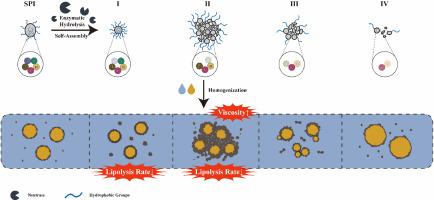当前位置:
X-MOL 学术
›
Food Hydrocoll.
›
论文详情
Our official English website, www.x-mol.net, welcomes your
feedback! (Note: you will need to create a separate account there.)
Soy proteins with various surface properties prepared by limited enzymatic hydrolysis and their potential on emulsion thickening and controlling lipolysis
Food Hydrocolloids ( IF 11.0 ) Pub Date : 2024-06-07 , DOI: 10.1016/j.foodhyd.2024.110274 Jinjin Wu , Weiye Liu , Min Zhong , Mouming Zhao , Qiangzhong Zhao , Feibai Zhou
Food Hydrocolloids ( IF 11.0 ) Pub Date : 2024-06-07 , DOI: 10.1016/j.foodhyd.2024.110274 Jinjin Wu , Weiye Liu , Min Zhong , Mouming Zhao , Qiangzhong Zhao , Feibai Zhou

|
In recent years, proteins with designed surface properties as interfacial stabilizers to obtain functional emulsions with controlled lipolysis has received increasing attention. In this work, four types of soy proteins (I, II, III, IV) with different surface properties were obtained by controlled enzymatic hydrolysis (Neutrase). Protein particle size, morphology, surface hydrophobicity and interfacial wettability were analyzed along with changes in subunits composition and secondary structure, aiming to establish a certain relationship between protein surface properties and its capacity in modulating emulsion properties. Specifically, Type I (α’, α, β, A and B subunits) as protein nanoparticles showed high surface hydrophobicity (+84%) and could form a thick interface to delay lipolysis (-24.0%, -24.2%) through Pickering effect. Type II (α, β, A and B subunits) as protein aggregates in larger size showed high surface hydrophobicity (+45%) and roughness, which could enhance viscosity (equivalent to that of φ0.3–0.4 oil fraction) and delay lipolysis (-24.0%) by bridge flocculation. Further hydrolysis caused partial precipitation (originated from β and B subunits) and the soluble portion (Type III and IV) with decreased surface hydrophobicity and increased structural flexibility showed poor emulsification capacity and formed weak interface. It can be concluded that regulating subunit composition by enzymatic hydrolysis is an effective way to obtain proteins with multi-surface properties, which plays a vital role in modulating emulsion viscosity and lipolysis behavior. Results from the present study could provide a new strategy for the design of low-calorie emulsions for weight management.
中文翻译:

通过有限酶水解制备的具有各种表面性质的大豆蛋白及其在乳液增稠和控制脂肪分解方面的潜力
近年来,具有设计表面特性的蛋白质作为界面稳定剂以获得具有受控脂肪分解的功能性乳液受到越来越多的关注。在这项工作中,通过受控酶水解(Neutrase)获得了具有不同表面性质的四种类型的大豆蛋白(I、II、III、IV)。分析蛋白质粒径、形态、表面疏水性和界面润湿性以及亚基组成和二级结构的变化,旨在建立蛋白质表面性质与其调节乳液性质的能力之间的一定关系。具体来说,I型(α'、α、β、A和B亚基)作为蛋白质纳米颗粒表现出高表面疏水性(+84%),并可以通过皮克林效应形成厚界面来延迟脂肪分解(-24.0%、-24.2%) 。 II 型(α、β、A 和 B 亚基)作为较大尺寸的蛋白质聚集体,表现出高表面疏水性(+45%)和粗糙度,可以增强粘度(相当于 φ0.3-0.4 油馏分)并延迟脂肪分解(-24.0%) 通过桥絮凝。进一步水解导致部分沉淀(源自β和B亚基),表面疏水性降低、结构柔韧性增加的可溶部分(III型和IV型)乳化能力差并形成弱界面。由此可见,通过酶水解调节亚基组成是获得具有多表面特性的蛋白质的有效途径,在调节乳液粘度和脂肪分解行为中起着至关重要的作用。本研究的结果可以为设计用于体重管理的低热量乳液提供新策略。
更新日期:2024-06-07
中文翻译:

通过有限酶水解制备的具有各种表面性质的大豆蛋白及其在乳液增稠和控制脂肪分解方面的潜力
近年来,具有设计表面特性的蛋白质作为界面稳定剂以获得具有受控脂肪分解的功能性乳液受到越来越多的关注。在这项工作中,通过受控酶水解(Neutrase)获得了具有不同表面性质的四种类型的大豆蛋白(I、II、III、IV)。分析蛋白质粒径、形态、表面疏水性和界面润湿性以及亚基组成和二级结构的变化,旨在建立蛋白质表面性质与其调节乳液性质的能力之间的一定关系。具体来说,I型(α'、α、β、A和B亚基)作为蛋白质纳米颗粒表现出高表面疏水性(+84%),并可以通过皮克林效应形成厚界面来延迟脂肪分解(-24.0%、-24.2%) 。 II 型(α、β、A 和 B 亚基)作为较大尺寸的蛋白质聚集体,表现出高表面疏水性(+45%)和粗糙度,可以增强粘度(相当于 φ0.3-0.4 油馏分)并延迟脂肪分解(-24.0%) 通过桥絮凝。进一步水解导致部分沉淀(源自β和B亚基),表面疏水性降低、结构柔韧性增加的可溶部分(III型和IV型)乳化能力差并形成弱界面。由此可见,通过酶水解调节亚基组成是获得具有多表面特性的蛋白质的有效途径,在调节乳液粘度和脂肪分解行为中起着至关重要的作用。本研究的结果可以为设计用于体重管理的低热量乳液提供新策略。















































 京公网安备 11010802027423号
京公网安备 11010802027423号